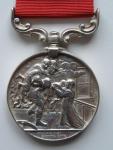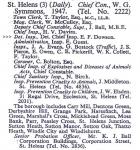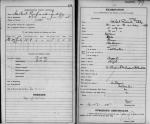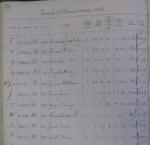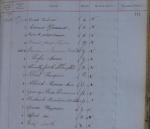-
Posts
276 -
Joined
-
Last visited
Content Type
Profiles
Forums
Blogs
Gallery
Events
Store
Everything posted by Odin Mk 3
-
Regret I can't find Rowther either - I tried the Discharge Registers without success. As it is an 1887 with no bar it may be that he left between June 1887 (Jubilee date) and March 1889 when the Discharge Registers start. I've never cracked how to identify the men who left in this period, other than those who died in service as they are listed in MEPO 4 / 2 (which covers to the end of 1889). I have checked and Rowther isn't in MEPO 4 / 2.
-
I would post it in the article section but because it is quite long and the way the pictures need to be displayed within the format, I don't think it will work properly in that section. I have it as a pdf file with the images in all the correct places but can't see how to post it on the Forum. It might be possible in the archives but then no one will find it I think.
-
Although I was happy with my display I didn't think it would necessarily go down that well when compared to other displays with gallantry groups etc. How wrong could I be - it won the Best of Show award and was voted by the Members as their favourite. That goes to show that Met police Medals can hold their own with other medals and with the right research can capture peoples attention. Download attachment: OMRS 2013-1.pdf Click here to view the article
-
I would say it is most likely the Society of the Protection of Life from Fire Medal which would be worn on the right hand breast. The medal usually had a scroll suspender and a top buckle clasp - the suspender was changed later to a straight suspender - I have seen early 1930 issues that had a different (non scroll) suspender. The men with a single medal on their left breasts could be wearing the 1911 Coronation (Police) Medal. Also I notice that the man who appears not to have this award has a medal with several bars on it after his Coronation / Jubilee Medals (Boer War / IGS 1895?). This would suggest the picture was taken after 1911 and near the start of WWI. Queen Victoria placed her Jubilee Medals before campaign medals - it was only in WWI that George V changed the order of wear and put the Jubilee / Coronation Medals after Campaign Medals.
-
Hello Cheryl Joseph Daniels joined the Met with the Warrant Number 71719 on 17/05/1886 and started as a PC in C Division (St James). He is shown in the Discharge Register as Died and was removed from the Police books on 23/05/1892. He had been serving in E Division before he died (Holborn). I'm afraid I can't help with the location of his 1887 Medal but it will be named to him as: PC J Daniels C Divn as he didn't move to E Division until after the Jubilee which was in June 1887. His divisional number when he died was 259 so any photos of him in uniform (at that time) would show him with the collar number 259E That's about all I can do for you I'm afraid - there won't be many more Police Records for him I'm afraid - no pension records / service sheet / gratuities register etc. Also the ledger which records the returns of deaths of officers and shows the cause of their deaths (MEPO 4/2) only goes up to 1889. I can e-mail you copies of pages from the Attestation and Discharge Registers if you want them
-
The most probable candidate is James Edward Wyatt who joined 4/4/1870 and left 8/4/1895 (he had taken his pension at the 25 year point) His warrant number was 52607 and when he finished his service he was still at 2nd Division (Portsmouth) as a PC (with the divisional number 62 - this information is from the Police Orders) Checking the Attestation Register shows James Wyatt joined as a PC in K Div (Bow) I'm afraid I can't tell you the dates of any moves for him - these will be shown in his pension papers which are at Kew but not available on line. There is no service sheet for him as he joined before these records start.. The Discharge Register shows that he left with a Class 1 Certificate (= Excellent) The 1887 Medal would appear to be his sole police medal entitlement (he did not return for the 1897 Jubilee) For general information - very few medals have more than one initial engraved on them - the vast majority show only the first initial (I have just one in my collection with two initials on it and even then the second one is actually incorrect!). Also on joining the Police Orders entry normally shows only one first name. However if you look at the attestation register for the men when they joined, most appear to have signed the register with their full name (in this case he wrote James Edward Wyatt). In addition the full name is also usually given on the Discharge Register. Checking the service sheet (if there is one) may also give you the full name for the individual but not always. All these three sets of records (Attestation and Discharge Registers and Service Sheets) are available on-line from the National Archives and can be downloaded for free - all are in the MEPO 4 series of records BUT you need to know the Warrant Number to find two of them and date of discharge for the Discharge Register - otherwise forget the haystack, it would be like looking for a needle in a cornfield!
-
I have been puzzled by this post since Peter first started it. I originally thought it related to the 1911 Coronation but the question I kept asking myself - if the man had previous service then why isn't the chap wearing a 1902 Coronation Medal Ribbon? I know that men, mainly pensioners, who returned in 1911 for that event were technically posted to the mythical O Division. Almost certainly all would have been serving in 1902 and probably before that. However in practice most pensioners went back to their old divisions which was also recorded in the Police Orders and they would have worn the Divisional letter of that Division (and not an O). Yesterday I was looking through my copy of The Official Encyclopedia of Scotland Yard by Fido and Skinner and in there it states: O DIVISION Because of the possibility of confusion with the numeral zero, there is no territorial O Division, for which reason the fictitious Division of television's police series The Bill carries the letter. But on at least two occasions, 6 May 1935 and 12 May 1937, there was an actual O Division of sworn-in constables with correct uniforms and their Divisional numbers on their collars. The shortage of officers to police the Silver Jubilee procession of George V and the coronation procession of King George VI meant that recruits at Peel House were administered the Oath of Allegiance and given specially made uniforms. For the Silver Jubilee procession, the new O Division constables were sworn in at Scotland Yard a couple of days earlier. For the coronation processions, their successors took their oath at 4.30 am in the boot-room at Peel House. Both groups paraded to the Mall, where they stood behind the Guards lining the route until 4.00 pm. The Silver Jubilee's O Division were within a day of passing out and being posted to Divisions. They spent the evening removing the Os from their uniforms. The Coronation Day O Division were allowed to wear the uniforms home, and retained them long enough for a photograph of their short-lived Division to be taken. So I would hazard a guess that the man (who doesn't look that old) was perhaps a 1937 recruit who managed to get his photo taken before the O Div was disbanded. They may have also selected a number of the older candidates to be acting sergeant for the day, hence the Corporal's stripes.
-
David St Helen's Police was formed 1 July 1887 (previously part of Lancashire force) It was abolished 1 April 1969 when it became part of the Lancashire force I have looked in the Police Almanacs for 1951 and 1957 and can find no trace of him in the 1951 edition (which suggests he may have been serving in another force or was possibly below the rank of Inspector which is the lowest shown for that force He does appear in the 1957 edition as a Ch Insp - he was their senior detective. See attached for the complete entry for St Helen's (1957 edition)
-
J Barnes is probably PC John Barnes Warrant Number 58422; he joined 16/11/1874 as a PC in P Div (Camberwell) and left 31/12/1891; he was then still a PC in P Div. Left under a cloud as his Resignation was Permitted (RP - later this terminology was changed to Required to Resign). E Andrews 1887 - N Div (Islington). Sorry I can't identify this man - he either left between June 1887 and early 1889 when the discharge registers start or transferred to another division before he left and thereby wiping out our only clue, his the link to N Div. C Cox is PC Charles Cox Warrant Number 81300; he joined 01/06/1896 as a PC in V Div (Wandsworth) and was pensioned 05/06/1922 as a PC in L Div (Lambeth). He earned an 1897 Jubilee Medal (PC V Div), 1902 Coronation Medal (PC V Div), 1911 Coronation Medal (PC).
-
That's not a problem - this is definitely PC Arthur Bragg - Warrant Number 69494. There are no other suitable candidates for this pair of medals. Bragg definitely started in C Div (St James'), I know he was in R Div before 1897 and that he went to B Div before he retired. When I was producing the book I found I had gaps for some men - in Bragg's case I wasn't 100% sure exactly where he was serving in 1887 (hence why the R Div is shown in italics for his 1887 entry). Thanks to you sighting the actual medals you have confirmed he was actually serving in E Div (Holborn) when he earned his 1887 Medal. I will add a correction to my list which will ultimately be published on my website.
-
Looked at his service sheet and that just repeats the information you already have Copy of his service sheet attached in case you don't have it He started in D Div (Marylebone)and earned his 1911 Medal there. Then went to F Div (Paddington) as a PS and finally to S Div (Hampstead) as an SPS. Not sure exactly where his cause of death would be recorded by the Met
-
You listed three Met police medals above: 307 P.C. Gray, F. M Division c1900-1902 1 Coronation Medal, 1902 (Police) (EVIIR) This is PC Frank Gray Warrant Number 75389 who joined as a PC in M Div 10/03/1890 and was pensioned as PC in B Div (Chelsea) 23/08/1911 His full entitlement is the 1897 Jubilee Medal (PC M Div), 1902 Coronation Medal (PC M Div) and 1911 Coronation (PC). 437 Inspector Collins, T F Division c1880-1887 1 Jubilee Medal, 1887 (Police)(VR) This is almost certainly Inspector Thomas Robert Collins who joined the Met 25/05/1868 as a PC and was pensioned as an Inspector in F Div 28/05/1894 - his Warrant Number was 50466 - the 1887 Medal is his sole entitlement. 308 Pol.Sgt Butt, J London Met. Police c.1900 + 1 Coronation Medal, 1911(Police)(GVR) Not totally clear from your post but this looks like James Butt who joined as a PC in G Div (Finsbury) 31/08/1903 Warrant Number 90045 {note he did not earn the 1902 Coronation Medal} and was pensioned 18/03/1927 as a Det Insp in S Div (Hampstead) . His sole entitlement is the 1911 Coronation Medal as a PS.
-
I found a PC Henry Smith Warrant Number 59479 who joined 10/10/1875 as a PC in X Div and left 1/12/1898 as a PC in P Div. He got a Class 1 Certificate (=excellent) when he left. X Div = Kilburn P Div = Camberwell I cannot confirm the date he transferred to P Div but I think he is the most likely candidate for this medal Pages from the Attestation and Discharge Registers are attached
-
Given the close proximity of his leaving date to the Jubilee it could be that when the list of N Div officers was compiled (needed for the engraver of the 1887 Medals) they mistakenly included your man in error. The naming does appear to be the sloping capitals style used for this issue and from the images there might even be the faint guide lines which are noticeable on some medals; these were used to get the letters all the same height. Without actually handling the medal I'm inclined to favour your suggestion that this medal was issued in error to him after he had left.
-
On 10/07/1899 a PC Edward J Thomas retired - his Warrant Number was 58017 but more importantly his Divisional Number was 128W. He had joined the force on 06/07/1874. Given the date of the book I think it is highly probable that this is your man, particularly as I can't find anyone else serving just before that date with that Divisional Number. The Discharge Register shows PC Thomas got a Class 2 Certificate (Very Good) so clearly his Sergeant didn't catch him smoking very often. Incidentally they didn't waste much time as on the same day they re-allocated his number (128W) to a new recruit - PC Frederick Meyer-Dixon. It would be great if you could post a large size image of the picture.
-
Apart from the info above I can tell you When he joined his Divisional Number (ie on his collar / helmet) was 387J. His number later changed to 121J before he left J Div. On the 1st March 1892 he transferred to F Div (with the number 225F) On 12th March 1904 he became part of F Division Mobile Reserve and would not have normally patrolled a beat. His number changed to 20FR I can't tell you when he transferred to B Div but his number when he retired was definitely 322B Unfortunately there will be no service sheet for him (joined too early for those) but there will be an entry in the Attestation and Discharge Registers plus a pension record for him. The latter will give a brief summary of his career.
-
As far as I am aware the medal was authorised after the actual procession because the Queen was very pleased with the way everything went for the event and the part played by the Police. The medal was then issued to all men who were on the strength of the Met Police on the day of the actual procession, irrespective of whether they actaully manned the route or not (for example most of the Dockyard Divisions 1st - 5th Divs wouldn't have been in London). It may be that some officers who had recently left the force might have erroneously been included on the list of intended resipients BUT from the initial post about this medal it also has the 1897 bar (10 year clasp). To me it seems highly unlikely they would make the same mistake twice and I believe there is definitely something not quite right here. I would add that I have never before come across an example of a Met Police Coronation or Jubilee Medal named to a man who had already left the force other than those issued for the Police Pensioners. These men returned for a short period to help with policing the various events and they can usually be identified from their previous service and then linked to their earlier Warrant Numbers. The practice of re-employing pensioners was valid for the 1897, 1902 and 1911 events only and was not used for 1887 which was effectively the first time such an event had been held.





